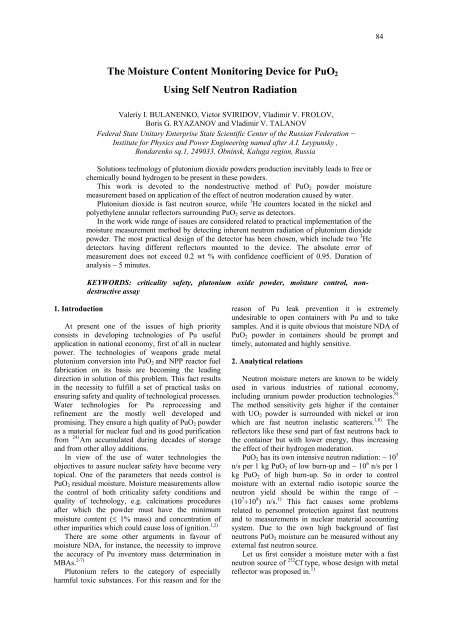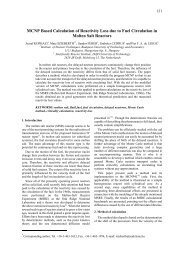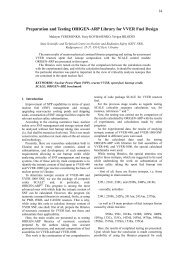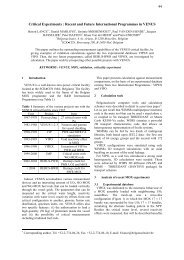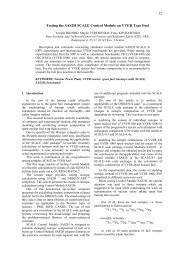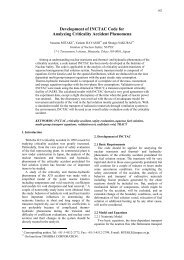The Moisture Content Monitoring Device for PuO2 Using Self ...
The Moisture Content Monitoring Device for PuO2 Using Self ...
The Moisture Content Monitoring Device for PuO2 Using Self ...
You also want an ePaper? Increase the reach of your titles
YUMPU automatically turns print PDFs into web optimized ePapers that Google loves.
<strong>The</strong> <strong>Moisture</strong> <strong>Content</strong> <strong>Monitoring</strong> <strong>Device</strong> <strong>for</strong> PuO 2<br />
<strong>Using</strong> <strong>Self</strong> Neutron Radiation<br />
Valeriy I. BULANENKO, Victor SVIRIDOV, Vladimir V. FROLOV,<br />
Boris G. RYAZANOV and Vladimir V. TALANOV<br />
Federal State Unitary Enterprise State Scientific Center of the Russian Federation –<br />
Institute <strong>for</strong> Physics and Power Engineering named after A.I. Leypunsky ,<br />
Bondarenko sq.1, 249033, Obninsk, Kaluga region, Russia<br />
Solutions technology of plutonium dioxide powders production inevitably leads to free or<br />
chemically bound hydrogen to be present in these powders.<br />
This work is devoted to the nondestructive method of PuO 2 powder moisture<br />
measurement based on application of the effect of neutron moderation caused by water.<br />
Plutonium dioxide is fast neutron source, while 3 He counters located in the nickel and<br />
polyethylene annular reflectors surrounding PuO 2 serve as detectors.<br />
In the work wide range of issues are considered related to practical implementation of the<br />
moisture measurement method by detecting inherent neutron radiation of plutonium dioxide<br />
powder. <strong>The</strong> most practical design of the detector has been chosen, which include two 3 He<br />
detectors having different reflectors mounted to the device. <strong>The</strong> absolute error of<br />
measurement does not exceed 0.2 wt % with confidence coefficient of 0.95. Duration of<br />
analysis ~ 5 minutes.<br />
KEYWORDS: criticality safety, plutonium oxide powder, moisture control, nondestructive<br />
assay<br />
1. Introduction<br />
At present one of the issues of high priority<br />
consists in developing technologies of Pu useful<br />
application in national economy, first of all in nuclear<br />
power. <strong>The</strong> technologies of weapons grade metal<br />
plutonium conversion into PuO 2 and NPP reactor fuel<br />
fabrication on its basis are becoming the leading<br />
direction in solution of this problem. This fact results<br />
in the necessity to fulfill a set of practical tasks on<br />
ensuring safety and quality of technological processes.<br />
Water technologies <strong>for</strong> Pu reprocessing and<br />
refinement are the mostly well developed and<br />
promising. <strong>The</strong>y ensure a high quality of PuO 2 powder<br />
as a material <strong>for</strong> nuclear fuel and its good purification<br />
from 241 Am accumulated during decades of storage<br />
and from other alloy additions.<br />
In view of the use of water technologies the<br />
objectives to assure nuclear safety have become very<br />
topical. One of the parameters that needs control is<br />
PuO 2 residual moisture. <strong>Moisture</strong> measurements allow<br />
the control of both criticality safety conditions and<br />
quality of technology, e.g. calcinations procedures<br />
after which the powder must have the minimum<br />
moisture content (≤ 1% mass) and concentration of<br />
other impurities which could cause loss of ignition. 1,2)<br />
<strong>The</strong>re are some other arguments in favour of<br />
moisture NDA, <strong>for</strong> instance, the necessity to improve<br />
the accuracy of Pu inventory mass determination in<br />
MBAs. 2-7)<br />
Plutonium refers to the category of especially<br />
harmful toxic substances. For this reason and <strong>for</strong> the<br />
reason of Pu leak prevention it is extremely<br />
undesirable to open containers with Pu and to take<br />
samples. And it is quite obvious that moisture NDA of<br />
PuO 2 powder in containers should be prompt and<br />
timely, automated and highly sensitive.<br />
2. Analytical relations<br />
Neutron moisture meters are known to be widely<br />
used in various industries of national economy,<br />
including uranium powder production technologies. 8)<br />
<strong>The</strong> method sensitivity gets higher if the container<br />
with UO 2 powder is surrounded with nickel or iron<br />
which are fast neutron inelastic scatterers. 1,8) <strong>The</strong><br />
reflectors like these send part of fast neutrons back to<br />
the container but with lower energy, thus increasing<br />
the effect of their hydrogen moderation.<br />
PuO 2 has its own intensive neutron radiation: ~ 10 5<br />
n/s per 1 kg PuO 2 of low burn-up and ~ 10 6 n/s per 1<br />
kg PuO 2 of high burn-up. So in order to control<br />
moisture with an external radio isotopic source the<br />
neutron yield should be within the range of ~<br />
(10 7 ÷10 8 ) n/s. 1) This fact causes some problems<br />
related to personnel protection against fast neutrons<br />
and to measurements in nuclear material accounting<br />
system. Due to the own high background of fast<br />
neutrons PuO 2 moisture can be measured without any<br />
external fast neutron source.<br />
Let us first consider a moisture meter with a fast<br />
neutron source of 252 Cf type, whose design with metal<br />
reflector was proposed in. 1)
<strong>The</strong> analytical signal <strong>for</strong> the initial moisture range<br />
is expressed by the linear function<br />
similar to (1).<br />
Let us get the ratio<br />
N = No ⋅(<br />
1 + K ⋅W )<br />
(1)<br />
N1<br />
No<br />
+ K ⋅W<br />
= 1 1<br />
⋅ 1<br />
,<br />
where N − is the count rate being measured, pulse/s; N2<br />
No2<br />
1+<br />
K2<br />
⋅W<br />
(4)<br />
W − is <strong>PuO2</strong> moisture, wt %; N o − is the count rate at<br />
W = 0 wt %, which is a calibration parameter of the in which the ratio ( No1 / No2<br />
) does not depend on fast<br />
moisture meter; K − is the proportionality factor neutron yield variation in <strong>PuO2</strong> powder and is<br />
which represents the slope of calibration parameter or measured in the course of calibration tests.<br />
sensitivity of the method ( dN N o )/<br />
W , it is Detectors D 1 and D 2 should be designed in such<br />
independent of the source neutron yield.<br />
a way that K1 >> K 2 . With this condition and due to<br />
In this option the moisture meter has a number of<br />
a low value of moisture W equation (4) is modified in<br />
drawbacks:<br />
the following way<br />
1. A high fast neutron yield is required from the<br />
252 Cf point source.<br />
2. A drastically non-uni<strong>for</strong>m fast neutron field is N1 N<br />
= o1<br />
⋅ [ 1 + ( K1<br />
− K2<br />
) ⋅W<br />
]<br />
<strong>for</strong>med in PuO 2 powder.<br />
N2<br />
No2<br />
(5)<br />
3. <strong>The</strong> effects of powder bulk density and mass<br />
become significant. <strong>The</strong>y require an additional<br />
correction of the signal being measured.<br />
<strong>The</strong>re is another moisture meter option, which is<br />
more sensitive to moisture. In this option the PuO 2<br />
Ni<br />
own neutron radiation uni<strong>for</strong>mly generated within the<br />
volume is used instead of 252 Cf. In this case the<br />
analytical moisture signal is generated additively by<br />
three effects:<br />
∗ <strong>The</strong> neutron spectrum gets softer and the<br />
detector efficiency grows.<br />
∗ (α,n)-reaction yield grows due to the increase<br />
in oxygen weight fraction.<br />
∗ <strong>The</strong> neutron multiplication grows due to<br />
additional elastic neutron scattering on<br />
hydrogen nuclei.<br />
Numerical values of each effect at the registration<br />
Fig.1 “Joint” detection unit design <strong>for</strong> moisture meter.<br />
of double neutron coincidences (doubles) <strong>for</strong> the Detector D2<br />
could be designed so that K2<br />
would<br />
HLNCC-II detector with a polyethylene moderator are<br />
given in. 3) <strong>The</strong> dominating contribution comes from<br />
have a negative value. In this case the calibration<br />
the increase in the (α,n)-reaction yield.<br />
curve slope (sensitivity) would increase ( K1<br />
+ K 2 ) .<br />
<strong>The</strong> own fast neutron yield can vary and depends<br />
on PuO 2 mass in the container, Pu isotopic<br />
In this option the moisture meter is assumed to consist<br />
of two detectors with opposite responses to PuO 2<br />
composition,<br />
Am fraction and light element powder moisture. However detector D2<br />
cannot be<br />
impurities in PuO 2 . In this case equation (1) does not considered as PuO 2 fast neutron yield monitor because<br />
meet the assay conditions because of N o variations. this detector, similar to detector D 1 , also responses to<br />
One of the ways to eliminate this methodological error the effect of fast neutron count rate growth due to their<br />
consists in introducing the second detection unit,<br />
multiplication and the growth of (α,n)-reaction<br />
independent of the first one, thus resulting in twoparametric<br />
moisture assay. So detector D 1 (nickel <strong>The</strong> two options considered above can be<br />
neutron contribution with the increase in moisture.<br />
reflector) and detector D 2 (polyethylene reflector) are presented in the <strong>for</strong>m of one “joint” configuration<br />
independent and the container with <strong>PuO2</strong> is loaded shown in fig.1. In this variant signals N 1 and N 2 are<br />
into them successively.<br />
registered at the same time and with one operation of<br />
<strong>The</strong> operation of such a “combined” moisture PuO 2 , container loading-unloading, thus reducing the<br />
meter can be described by two equations:<br />
time of one measurement and making its automation<br />
simpler. However, when combining detectors D 1 and<br />
N1 = No1<br />
⋅(<br />
1+<br />
K1<br />
⋅W<br />
)<br />
(2) D2<br />
the main effect (fast neutron moderation) can<br />
N2 = No2<br />
⋅(<br />
1 + K2<br />
⋅W<br />
)<br />
(3) decrease.
3. Detection unit characteristics.<br />
<strong>The</strong> main objectives of the study are to optimize<br />
the principal parameters of moisture meter detector<br />
and to determine the calibration curve parameters with<br />
estimation of influencing factors.<br />
Evidently the most complete in<strong>for</strong>mation about the<br />
dependence of in<strong>for</strong>mation signal (assay parameter)<br />
on moisture can be only obtained by means of<br />
calibration procedure with the use of real PuO 2<br />
powder samples. If considered in full scope this<br />
procedure is quite a lab our-consuming task because it<br />
requires preparation of samples as reference materials<br />
with certified characteristics of moisture, Pu isotopic<br />
composition and Pu mass.<br />
With all these factors in view, metal plutonium in<br />
the <strong>for</strong>m of standard discs of the BFS–1 type was<br />
chosen <strong>for</strong> test modeling as an object of assay. <strong>The</strong>se<br />
discs have the diameter of 46.7 mm and the height of<br />
3.5 mm. <strong>The</strong>ir external clad is made of stainless steel<br />
and has the thickness of 0.3 mm. Each disc contains ~<br />
52.5 g Pu. <strong>The</strong> total Pu mass in the container was<br />
equal to m = 2534.4 g Pu, and neutron yield was ~<br />
1.178×⋅10<br />
5 n/s, with the multiplication not taken into<br />
account.<br />
Water was simulated with thin polyethylene films<br />
in the <strong>for</strong>m of circles with diameters equal to disc<br />
diameter. <strong>The</strong> number of polyethylene circles was<br />
chosen from the condition of moisture range from 0 to<br />
5 wt %. <strong>The</strong> equivalent moisture was calculated<br />
relative to Pu mass in view of different hydrogen<br />
concentration in water and polyethylene. In order to<br />
simulate different density of materials the aluminum<br />
discs were used with the diameter of 46.5 mm and the<br />
height of 5 mm.<br />
<strong>The</strong> object under measurement consisted of 4<br />
columns placed close to one another in a cylindrical<br />
cup with a cover. <strong>The</strong> following variants of stacking<br />
the container were studied:<br />
a) <strong>The</strong> high-density container with the average<br />
density ~ 5.3 g Pu/cm 3 . <strong>The</strong> polyethylene film was<br />
placed between each two Pu discs.<br />
b) <strong>The</strong> basic container with the average density<br />
~ 3.1 g Pu/cm 3 . In each column between two<br />
BFS–1 discs one aluminum disc was placed.<br />
c) <strong>The</strong> low-density container with ~ 2.2 g Pu/cm 3 ,<br />
with the double number of aluminum discs.<br />
<strong>The</strong> set of these containers made it possible to<br />
simulate various characteristics of the object being<br />
measured (Pu density, moisture, arrangement<br />
geometry, etc).<br />
In the experiments 3 options of detection units<br />
were studied:<br />
∗ A - ”basic” detection unit D 1 , without any<br />
external neutron source.<br />
∗ B - “combined” detection unit, i.e. combination<br />
of two detectors, and D .<br />
D1<br />
2<br />
∗ C - “joint” detection unit shown in fig.1.<br />
In all the moisture meter options SNM–18 neutron<br />
counters filled with 3 He up to 4 atm, with the diameter<br />
of 32 mm and active part length of 270 m, or SHM–17<br />
counters filled with 3 He up to 7 atm, with the diameter<br />
of 18 mm and the length of its active part of 160 mm,<br />
were used as detector D 1 .<br />
<strong>The</strong> “basic” detection unit with the nickel reflector<br />
(option A) had the outer diameter of 464 mm and the<br />
height of 480 mm. <strong>The</strong> measurement cavity had the<br />
diameter of 132 m and the height of 280 mm. <strong>The</strong><br />
group of 4 SNM–18 counters was uni<strong>for</strong>mly<br />
distributed in the holes on the circumference with the<br />
radius of 90 mm, with the nickel layer thickness of 8<br />
mm in front of the counter surface. And one SNM–17<br />
counter was placed on the circumference with the<br />
radius of 86 mm. <strong>The</strong> second detector D 2 <strong>for</strong> the<br />
“combined” moisture meter (option B) had the same<br />
design, but its reflector was polyethylene and the outer<br />
diameter was reduced to 250 mm.<br />
In the “joint” detection unit (option C, fig.1) the<br />
compound counters D 2 were located on the<br />
circumference with the radius of R 1 = 150 mm or<br />
R2<br />
= 200 mm. Each counter had the external layer of<br />
organic glass of various thickness d . Its outer surface<br />
can be used to locate a layer of sheet cadmium on it<br />
with the thickness of 0.4 mm (types 1 ÷ 4). <strong>The</strong><br />
registration efficiency of these compound counters has<br />
different dependence on energy and responses in a<br />
different way on hydrogen content as part of the<br />
measured object.<br />
<strong>The</strong> counters characteristics were determined with<br />
252 Cf neutron source and coaxial moderator made of<br />
organic glass, with both being located in the<br />
measurement cavity.<br />
Table 1 Characteristics of counters <strong>for</strong> the “joint”<br />
option of moisture meter.<br />
D 1<br />
*)<br />
No 1<br />
*)<br />
∆N/No 1<br />
*)<br />
No 1<br />
*)<br />
∆N/No 1<br />
291.8 3.10 285.6 3.15<br />
D 2 d<br />
*)<br />
No 1<br />
*)<br />
∆N/No 1<br />
*)<br />
No 1<br />
*)<br />
∆N/No 1<br />
(mm) R 1 =150 mm R 2 =200 mm<br />
1 – 90.9 1.077 52.4 0.819<br />
2 10 1726.4 0.050 1023.1 0.015<br />
3 15 2963.9 - 0.015 1753.2 - 0.021<br />
4 25 6583.7 - 0.041 4017.0 - 0.094<br />
*) <strong>The</strong> relative error < 2 %<br />
Table 1 presents 2 sets of measurements <strong>for</strong><br />
different types of detectors , located at the<br />
distances R1<br />
and R1<br />
. <strong>The</strong> obvious increase in the<br />
registered count rate of the<br />
3 He counter is caused by<br />
the reduced average energy of moderated neutrons.<br />
When the distance between the detectors D 2 and<br />
measurement cavity goes up, the registered neutron<br />
flux goes down. At the same time compound detector<br />
present in the reflector introduces local perturbation<br />
D 2
into the neutron field, thus resulting in the decrease in<br />
the average neutron energy and corresponding<br />
increase in D 1 readings by (20÷50) %, if D 1 detectors<br />
are at the distance less than 80 mm from the D2<br />
.<br />
<strong>The</strong> D2<br />
detector quality criterion is the ratio of<br />
effect/background, i.e. the ratio of [ S − No<br />
] / N o ,<br />
where S − is the signal in the presence of moderator,<br />
and N o − is the signal only from the neutron source.<br />
Pay attention to the negative value of the<br />
effect/background ratio <strong>for</strong> the compound detectors of<br />
type 3 and 4.<br />
So Table 1 shows that <strong>for</strong> the “joint” option of<br />
moisture meter the use of compound counters (type 3<br />
and 4) is more preferable. In this case the D 2 detector<br />
can be placed as it is shown in fig.1 or outside the<br />
nickel reflector as an additional mending plate.<br />
4. Study of moisture meter response functions.<br />
Table 2 and fig.2-3 illustrate some results of model<br />
measurements: count rate <strong>for</strong> different detectors and<br />
detectors’ reading ratio: (SNM-18 or SNM-17)<br />
and<br />
Counts rate (1/sec)<br />
D 2<br />
40<br />
35<br />
30<br />
25<br />
20<br />
D 1<br />
(SNM-17; type 2, R=150 mm).<br />
Measured<br />
Calculated<br />
Calibration<br />
D 1<br />
(Ni SNM-18)<br />
15<br />
0 1 2 3 4 5<br />
Equivalent <strong>Moisture</strong> (wt %)<br />
Fig.2 Count rate in nickel reflector as a function of<br />
equivalent moisture of “basic” container<br />
<strong>The</strong> indicated data confirm the initial points of<br />
moisture assay technique stated earlier. In particular,<br />
within the studied range of equivalent moisture values<br />
(0 ÷ 5) wt %, the functional dependence of analytical<br />
signal is linear and follows equation (1).<br />
It should be stated that the experimental and<br />
calculated results with MMKFK-2 9) show a good<br />
agreement that is illustrated in fig.2. <strong>The</strong> calculated<br />
values indicated here are normalized on the value of<br />
equivalent moisture of 4 wt %.<br />
Ratio of counts rate D 1<br />
/ D 2<br />
0,45<br />
0,40<br />
0,35<br />
0,30<br />
0,25<br />
Highdense<br />
Middledense<br />
Lowdense<br />
Calibration<br />
D 1<br />
(Ni SNM-18)<br />
D 2<br />
(Ni SNM-17)<br />
(type 2; R1=150 mm)<br />
0,20<br />
0 1 2 3 4<br />
Equivalent <strong>Moisture</strong> (wt %)<br />
Fig.3 Count rate ratio as a function of equivalent<br />
moisture <strong>for</strong> “joint” moisture meter at different<br />
density of the object under measurement.<br />
<strong>The</strong> effect of density of the measured objects is<br />
actually reduced only to the shift of measured count<br />
rates because the slope factors practically coincide.<br />
<strong>The</strong> ratio of both detectors readings N1 / N 2 does not<br />
depend on Pu density in the objects under<br />
measurement (fig.2).<br />
Table 2 presents the calibration curve parameters<br />
<strong>for</strong> two options of moisture meters (A and B), when<br />
count rate is the in<strong>for</strong>mation parameters. which is<br />
measured.<br />
Table 2 Control parameters <strong>for</strong> moisture meter<br />
options A and B.<br />
# Detector No (1/s) K<br />
1 D 1 (Ni, SNM-18) 18.60<br />
± 0.14<br />
0.213<br />
± 0.005<br />
2 D 1 (Ni, SNM-17) 8.57<br />
± 0.13<br />
0.241<br />
± 0.010<br />
3 D 2 (Ni, SNM-17;<br />
type 2, R 1 =150 mm)<br />
79.86<br />
± 0.32<br />
0.0067<br />
± 0.0017<br />
4 D 2 (Ni, SNM-17;<br />
type 4, R 2 =200 mm)<br />
213.7<br />
± 1.0<br />
-0.0088<br />
± 0.0021<br />
5 D 2 (Polyethylene,<br />
SNM-17)<br />
478.4<br />
± 3.5<br />
-0.0168<br />
± 0.0030<br />
As the measurement results similar to those<br />
indicated in table 2 were obtained in the course of<br />
independent measurements all the data were processed<br />
in order to be able to compare the relative values of<br />
measured parameters and summarized in table 3.<br />
<strong>The</strong>se data show that the two-parametric method of<br />
moisture assay by means of D1<br />
and D2<br />
reading ratio<br />
provides a rather high sensitivity of moisture assay.<br />
Tables 2 and 3 illustrate that when the SNM–17<br />
counter is used the calibration curve slope (coefficient<br />
K ) turns out to be higher by 10% as compared to the<br />
SNM–18 counter. <strong>The</strong>se systematically overestimated
parameters of neutron moderation effect being<br />
observed with the SNM–17 counter encouraged<br />
additional studies of the given difference. For this<br />
purpose the radial count rate distribution, and<br />
N o<br />
effect/background ratios [ S − No ] / N o were<br />
measured depending on the nickel thickness between<br />
the measurement cavity and counter surface.<br />
Table 3 Control parameters <strong>for</strong> “combined” and<br />
“joint” moisture meter.<br />
Analytical signal: count rate ratio.<br />
# D 1 D 2 No 1 /No 2 K<br />
“Combined” meter (option B; D 1 ⇒Ni; D 2 ⇒CH 2 )<br />
1 SNM-18 Polyethylene<br />
CH 2<br />
0.0387<br />
± 0.005<br />
0.243<br />
± 0.008<br />
2 SNM-17 Polyethylene<br />
CH 2<br />
0.0178<br />
± 0.0003<br />
0.276<br />
± 0.013<br />
“Joint” meter (option C; only Ni)<br />
1 SNM-18 Ni; type 2, R 1 0.2337<br />
± 0.0020<br />
0.200<br />
± 0.005<br />
2 SNM-18 Ni; type 4, R 2 0.0871<br />
± 0.0080<br />
0.226<br />
± 0.006<br />
3 SNM-17 Ni; type 2, R 1 0.1078 0.228<br />
± 0.0017<br />
4 SNM-17 Ni; type 4, R 2 0.0400<br />
± 0.0007<br />
Relative values<br />
3,0<br />
2,5<br />
2,0<br />
1,5<br />
1,0<br />
0,5<br />
1<br />
± 0.010<br />
0.256<br />
± 0.011<br />
SNM-18<br />
SNM-17<br />
SNM-17<br />
0,0<br />
0 2 4 6 8 10 12 14 16<br />
Ni thickness (sm)<br />
Fig.4 Ratio dependence: effect/background (1) and<br />
background (2) as a function of neutron detector<br />
location in the nickel reflector<br />
Fig.4 shows the radial distribution of the<br />
dependence of both signals on the nickel thickness<br />
between the measurement cavity and outer SNM–17<br />
surface. <strong>The</strong> counter moved with the step of 28 mm. A<br />
cylindrical rod made of nickel was installed in the<br />
blind opening instead of the counter. <strong>The</strong> horizontal<br />
lines indicate the counters’ diameters within which the<br />
additive counter signal is generated. <strong>The</strong> background<br />
signal N o is seen to be a monotonous function, which<br />
smoothly dies out to the reflector periphery. At the<br />
2<br />
same time, the dependence <strong>for</strong> the effect / background<br />
ratio has a different pattern, because the moderator<br />
effect manifests itself first of all near the measurement<br />
cavity. So with the increase in the counter diameter<br />
the relative contribution of useful signal will be less as<br />
it is observed <strong>for</strong> the SNM–18 counter.<br />
5. Discussion of the results.<br />
<strong>The</strong> specific yield of PuO 2 own neutron radiation<br />
exceeds 10 5 n/s per 1 kg PuO 2 . This intensity of own<br />
neutrons allows the moisture assay by the methods of<br />
neutron radiometry.<br />
<strong>The</strong> main element of a neutron moisture meter is a<br />
well-type detector with a nickel reflector, which<br />
provides the required sensitivity of PuO 2 assay.<br />
<strong>The</strong> presented model studies show the principal<br />
possibilities to implement the following moisture<br />
meter options:<br />
A. <strong>Moisture</strong> meter with one detection unit;<br />
B. “Combined” option of two detection units;<br />
C. “Joint” detector option.<br />
For the A option of moisture meter the analytical<br />
moisture signal can be expressed as a linear function<br />
in the <strong>for</strong>m of (1). <strong>The</strong> N o value <strong>for</strong> each measured<br />
container is not measured but only corrected according<br />
to the Pu passport data. All the three above –<br />
mentioned effects caused by the <strong>PuO2</strong> moisture make<br />
an additive contribution to the method sensitivity. So<br />
in order to implement the first option the product<br />
passport data must be known, i.e. PuO 2 mass Pu,<br />
isotopic composition and 241 Am fraction.<br />
For the “combined” option the analytical moisture<br />
signal is expressed as a linear function of type (5). It is<br />
a ratio of two detectors’ readings, (nickel<br />
reflector) and D 2 (hydrogen-containing reflector). For<br />
this option the analytical signal is primarily related to<br />
fast neutron hydrogen thermalization effect. In this<br />
case neutron multiplication and (α,n)-reaction neutron<br />
contribution do not actually increase the assay<br />
sensitivity and the moisture assay results do not<br />
depend on these effects.<br />
<strong>The</strong> advantage of the “combined” moisture meter<br />
consists in assay independence on Pu isotopic<br />
composition and its mass, i.e. there is no need to<br />
introduce the correction of the parameter No1 / No2<br />
<strong>for</strong> <strong>PuO2</strong> powder in each measured container. In other<br />
words, the No1 / No2<br />
readings ratio is a meter<br />
calibration constant. Along with that this type of<br />
moisture meter has a drawback, which consists in the<br />
fact that it requires twice as much time to per<strong>for</strong>m two<br />
consecutive measurements, thus making the<br />
measurement procedure automation more<br />
complicated.<br />
<strong>The</strong> “joint” option has all the advantages of the<br />
“combined” option. In this case N 1 and N 2 signals<br />
are registered simultaneously during one operation of<br />
D 1
loading – unloading the cup with PuO 2 powder. So the<br />
“joint” option does not have any drawbacks indicated<br />
above and typical of other moisture meter options. In<br />
view of that the “joint” option is more preferable to<br />
control Pu moisture.<br />
<strong>The</strong> experimental and calculation model studies<br />
per<strong>for</strong>med with metal plutonium have shown that all<br />
the types of moisture meters provide practically the<br />
same assay sensitivity. <strong>The</strong> particular value of<br />
proportionality coefficient K is determined by the type<br />
of counters being used and is equal to 0.20÷0.27 at the<br />
moisture of 1% mass.<br />
Let us estimate the expected moisture assay error.<br />
For the N parameter (count rate or count rate ratio) the<br />
moisture is equal to<br />
N / N<br />
W =<br />
K<br />
o − 1<br />
(6)<br />
Fig.5 shows the example of calculated dependence<br />
of the assay relative error (curve 1) on PuO 2 moisture<br />
(with the mass of 3.0 kg). <strong>The</strong> option of two–<br />
parametric assay with the “joint” design of moisture<br />
meter has been considered. During the estimation<br />
consideration was given to the increase in (α,n)-<br />
neutron yield of the wet PuO 2 powder.<br />
Relative error (%)<br />
100<br />
10<br />
2<br />
1<br />
PuO 2<br />
1<br />
0 1 2 3 4 5 6<br />
Equivalent <strong>Moisture</strong> (wt %)<br />
Fig. 5 Relative error of PuO 2 moisture assay:<br />
1 – the error calculated with equation (5);<br />
2 – the total error, which only considers the<br />
uncertainty of curve parameters.<br />
<strong>The</strong> uncertainly of calibration curve parameters <strong>for</strong><br />
the well-certified reference materials gives the<br />
dependence (curve 2) indicated in fig.5. Actually this<br />
function shows the limit of the assay accuracy<br />
achievable by the method. <strong>The</strong> lower assay limit is<br />
less than 0.1 wt % and the moisture higher than 1.0 wt<br />
% can be measured with the relative error better than<br />
6%. <strong>The</strong> absolute value of moisture measurement is ~<br />
0,1 wt % and is practically constant up to the moisture<br />
value of wt 2%. It is determined by the volume of<br />
statistical in<strong>for</strong>mation being accumulated. At higher<br />
moisture value the uncertainty of calibration curve<br />
parameters starts to play the determining role. Due to<br />
that the absolute value increases twice at the moisture<br />
of 5 wt %.<br />
6. References:<br />
1) L. A. Foster, J. E. Malcom, N. Ensslin, D. Holslin,<br />
V. Verbinsky, “Measurement of <strong>Moisture</strong> in<br />
Plutonium Oxide <strong>Using</strong> Neutron Moderation,”<br />
LA-UR-99-3726, 1999.<br />
2) R. S. Marshall and T. R. Canada, “An NDA<br />
Techniques <strong>for</strong> the Assay of Wet Plutonium<br />
Oxalate,” in Proc. Institute of Nuclear Materials<br />
Management 21st Annual Meeting, West Palm<br />
Beach, Florida, July 2, 1980 (J. Inst. Nucl. Mater.<br />
Manag., 1980), vol. IX, p.107.<br />
3) J. E. Stewart, H. O. Menlove, “<strong>Moisture</strong><br />
Correction in Neutron Coincidence Counting of<br />
PuO 2 ,” Proceedings of the 3rd International<br />
Conference on Facility Operation Safeguards<br />
Interface, ANS, San Diego, p.289, 1987.<br />
4) J. E. Stewart, H. O. Menlove et al,<br />
“Instrumentation and Procedure <strong>for</strong> <strong>Moisture</strong><br />
Correction in Passive Neutron Coincidence<br />
Counting Assay of Bulk PuO 2 and MOX<br />
Powders,” report LA-12546-MS (ISPO-351), May<br />
1993.<br />
5) R. Carchon, P. De Baere, C. P. D. Verrecchia, B.<br />
G. R. Smith, “Investigation of the Effect on the<br />
Neutron Coincidence Counting <strong>for</strong> the Presence<br />
of <strong>Moisture</strong> when Measuring MOX Powder,”<br />
Proc. 11th Annual ESARDA Symp. on<br />
Safeguards and Nuclear Material Management,<br />
Luxemburg, June 1989, p.129,<br />
6) M. T. Swinhoe, “Use of Neutron Coincidence<br />
Counters <strong>for</strong> Moist Plutonium Oxide Samples and<br />
Plutonium Nitrate Solutions,” Harwell<br />
Laboratory, Ox<strong>for</strong>d sire, SRDP-R138, 1987.<br />
7) A. K. Gorobets, L. I. Demidov, Yu. I. Leschenko,<br />
“Experimental Study of <strong>Moisture</strong> Effects on<br />
Plutonium Fuel Measurement <strong>for</strong> Neutron<br />
Coincidence Counting with Coincidence<br />
Moments Determination,” Proc. 13th Annual<br />
ESARDA Symp. on Safeguards and Nuclear<br />
Material Management, Avigon, France, May,<br />
1991, p.305.<br />
8) V. V. Frolov, V. I. Bulanenko, V. V.<br />
Charychansky, “Neutron control of moisture in<br />
low enriched uranium dioxide,” Atomnaya<br />
Energy, 56, 3, 155 (1984).<br />
9) V. B. Polevoy, V. V. Leontyev, A. V.<br />
Ovchinnikov et al., “<strong>The</strong> Basic Package of<br />
ММКFК-2 Code System to Solve the Neutron<br />
Transport Problems in Reactor Physics by the<br />
Monte Carlo Method, (MMKFK-2-BASE),” Reg.,<br />
№00371 in CEP, IAE “KI”, (1996).


